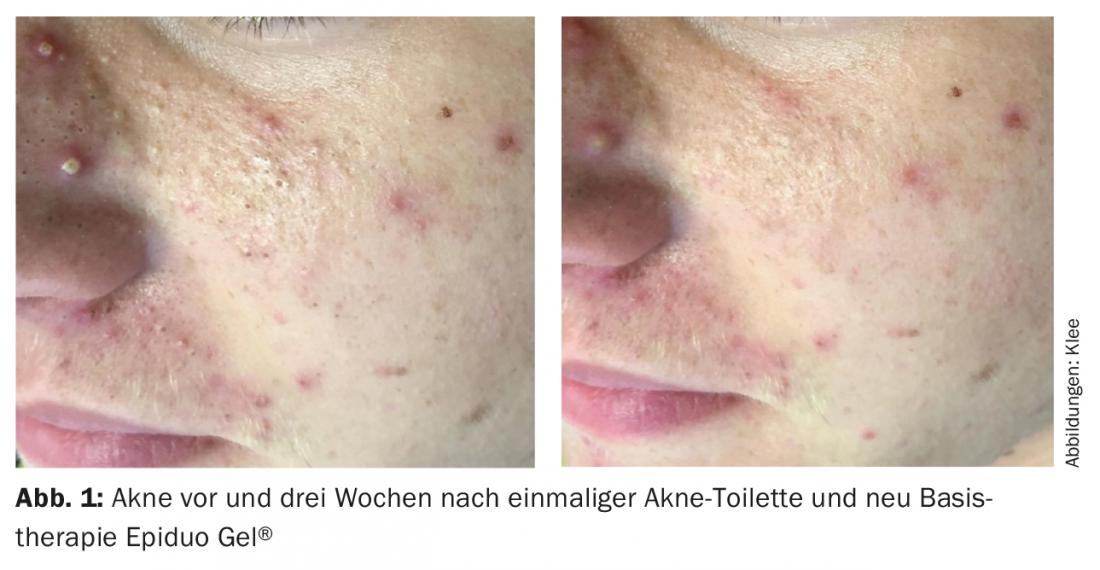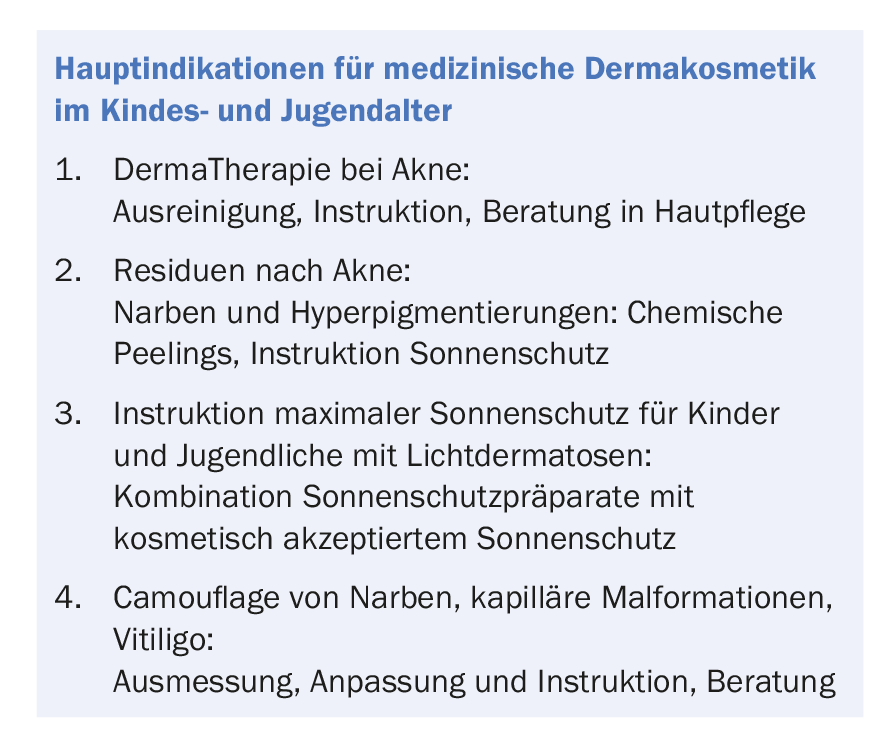Acne therapy, camouflage, sunscreen – medical cosmetics expertly assist busy dermatologists in treating common conditions of young skin.
Today, for the treatment of acne in adolescents as well as in children, we have several topical as well as systemic medications (partly only in off-label use) that have been proven for years. Today, there is usually not enough time in the daily consultation for the physical cleansing of comedones/microcysts. Here, cooperation with an appropriately trained cosmetician can contribute to a significant improvement in the success of the therapy. Similarly, the choice of high-quality sunscreen products for all age categories has increased significantly in recent years. Only through their correct application are they sufficiently effective at all. Through counseling and instruction, as well as ensuring an individually acceptable cosmetic solution for the patient, compliance is improved, especially for children and adolescents with UV-induced or even broad spectrum light-induced dermatoses.
Medical cosmetics and acne
Acne is the most common skin condition of all in the Western world, affecting >85% of adolescents in varying degrees of severity. The average onset today is eleven to twelve years, with children as young as eight increasingly affected. The psychosocial significance of acne is relevant and has been judged in studies to be comparable to diabetes mellitus and arthritis. Adolescents with severe acne show an increased tendency toward depression and social withdrawal [1]. Early therapy that is effective as quickly as possible and adapted to the current clinic should therefore be sought.
Medical cosmetics can make an adjuvant contribution here from three sides:
- Professional cleansing of comedones/microcysts and pustules (as well as any milia that may be present). The correct mechanical cleansing takes place without further traumatization of the surrounding tissue and thus without scarring. Decisive for the success of the therapy is appropriate training, as well as experience of the cosmetic specialist. A more rapid improvement in the skin’s appearance than with drug treatment alone is usually achieved in this way. The acne toilet procedure (Fig. 1) is individually adapted to the current clinic. Basically, after skin analysis, this includes mild cleansing of the facial skin, followed by the actual acne toilet described above, and in individual cases, subsequent application of an anti-inflammatory mask with or without antibacterial blue light application. In addition, chemical peels can be used in a targeted manner, especially in the case of relevant hyperkeratoses. These are also used in the course if necessary for the treatment of residuals after acne, first of all post-lesional hyperpigmentation. In adolescents, treatment usually lasts from 30 to max. 40 minutes, although several shorter treatments of 20 minutes are sometimes preferable, especially for younger patients. Depending on the extent and severity of the acne, two to six total sessions at two- to four-week intervals must be expected. Unfortunately, the costs are less and less frequently covered by health insurance. The cost is generally around CHF 60-80 per treatment.
- Counseling and instruction also increase compliance with concurrent drug therapy.
- In addition, in the age of social media and “cosmetic influencers,” expert advice in the sense of coaching is becoming increasingly important. On the one hand, this involves evaluating the products presented there and their suitability for the current skin type together with the young person. The skin care products and cosmetics already purchased can be reviewed together for usefulness and compatibility with current drug therapy. In most cases, this cooperation then results in a simplification and improvement of daily skin care, the adolescent is thus further strengthened in the independent and safe handling of his or her skin treatment, and thus compliance in general [2].

Medical cosmetics and camouflage
The aim of camouflage is an optimal and cosmetically appealing covering and balancing of subjectively relevant disturbing skin changes, whether on the face or on the body. The psychosocial stress of the adolescent is thus taken seriously and the skin changes are alleviated by this technique in everyday life or on special occasions. Individually and perfectly mixed shades are usually applied in cream form to the troublesome skin area and can be fixed in a sweat-, abrasion- and water-resistant manner if required. Proven product lines are available. The young people are precisely instructed in their handling. Like the acne toilet, health insurance companies are covering camouflage treatments less and less. However, it is worth asking about cost sharing in individual cases.
Medical cosmetics and light dermatoses: UV protection and broad-spectrum light protection
For children and adolescents, who for various reasons require optimal sun protection, be it UV protection or light protection, the individual fitting of a medically and cosmetically optimal sun protection and instruction in its use is decisive for compliance and thus usually also for the course of the underlying disease. This particularly concerns children and adolescents with lupus erythematosus, adolescents under immunosuppression in st.n. Organ transplantation, resp. St.n. Chemotherapies, and adolescents with photodermatoses.
In summary, in interdisciplinary cooperation with an appropriately trained and experienced cosmetician, the success of acne therapy in children and adolescents can be improved in most cases. Counseling and instruction in the use of customized sunscreen products that are also cosmetically acceptable favors adolescent compliance and is critical to the long-term course of UV- and light-dependent dermatoses.
Take-Home Messages
- Today, interdisciplinarity is an integral part of modern medicine.
- In pediatric and adolescent dermatology, cooperation with experienced and certified cosmeticians is also useful and important, especially in the areas of acne therapy, camouflage and sun protection.
- This allows for more rapid visible therapeutic success and mitigation of residual effects after skin diseases.
Literature:
- Halvorsen JA, et al: Suicidal ideation, mental health problems and social impairment are increased in adolescents with acne: a population-based study. J Invest Dermatol 2011; 131(2): 363-370.
- Baldwin HE. Tricks for improving compliance with acne therapy. Dermatol Ther 2006; 19(4): 224-236.
DERMATOLOGIE PRAXIS 2018; 28(5): 16-18












